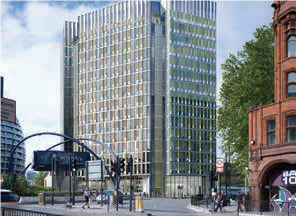
The amount of office space that actively contributes to business operations and drives productivity among staff is increasing as occupiers and landlords better realise the benefit of such changes.
Occupiers are increasingly demanding office buildings that meet their wellness requirements and are willing to pay higher rents for the provisions if it will provide the advantage of driving firm profitability in the long run. A number of landlords are adopting such changes and improving the services on offer within their buildings. Buildings that have adopted such changes have seen greater occupation and higher rents, also enabling a more secure income stream with a more diverse tenant mix.
Wellness
According to the Property Industry Alliance (PIA) 2015 data report, staff costs account for around 90% of an office occupiers’ total operating costs with business rates (3%) and rent (7%) falling further behind. It therefore follows that employee productivity should be a major concern, rather than office costs. An interesting study by the CBI found that absence from work through sickness typically costs the economy in the region of £14bn per annum. As a comparison, PIA estimates annual rental costs typically cost office occupiers in the region of £16bn.
The new WELL Building Standard provides a benchmark for buildings that are seeking to advance human health and wellbeing, encouraging sustainable future office design. 22 Bishopsgate, which is currently under construction, was the first building in the UK to be registered for the WELL Building Standard by putting health and wellness at the centre of design and construction decisions. Not only will the standard boost employee wellbeing, the measure is likely to assist in the generation of increased rental income by encouraging employee focused occupiers to pay more for the better quality of building.
The scheme at 22 Bishopsgate has been described as more of a hotel than an office building due to the large number of amenities to be offered to its tenants ranging from music lessons, a library, spa, club, exercise rooms, food market and even TED talks. This service offering has already proven to be appealing with Aspen close to taking around 90,000 sq ft at the building which is scheduled to complete in 2019.
Examples of wellness provision include space to encourage exercise, for example at the White Collar Factory where Derwent London has provided tenants with a running track on the roof; at 4 Kingdom Street where British Land have provided a basketball court; and at the Republic development in Canary Wharf, LaSalle will be providing tenants with a gym, internal climbing wall and a triathlon centre. The provision of such amenities is becoming increasingly popular as landlords, and occupiers, begin to appreciate the importance of wellness in boosting employee productivity.
Landlords can often encourage wellness in buildings in less obvious ways. For example, in buildings such as 25 Farringdon Street and the International Quarter development, landlords have designed the space to encourage walking, hiding the lifts and enhancing staircases by making them a central feature.
 Finally, a good environment can go a long way to improving health, and therefore productivity. At Derwent’s White Collar Factory and GPE’s 30 Broadwick Street, the windows are openable to allow natural ventilation and the façade’s glazing at White Collar Factory varies depending on orientation of the sun. The White Collar Factory recently achieved fully let status to a diverse range of occupiers including Adobe, AKT II, BGL, The Office Group and Spark44. The building has also achieved rents above average for the area.
Finally, a good environment can go a long way to improving health, and therefore productivity. At Derwent’s White Collar Factory and GPE’s 30 Broadwick Street, the windows are openable to allow natural ventilation and the façade’s glazing at White Collar Factory varies depending on orientation of the sun. The White Collar Factory recently achieved fully let status to a diverse range of occupiers including Adobe, AKT II, BGL, The Office Group and Spark44. The building has also achieved rents above average for the area.
Developments are also increasingly providing outdoor or ‘green’ space, with many schemes providing terraces or parks. An interesting example is Ampersand in Soho, where the landlord provided a spiral living staircase with meeting spaces between the spirals. Ampersand let to King Digital in August 2015 at a rent of £78.50 per sq ft.
Flexibility
Breakout areas and communal/collaboration space are increasingly common within office buildings and such features are increasingly highly sought after by tenants in the age of flexible working. One option is for landlords to provide their tenants with breakout areas for use by all occupiers within a building. At Landsec’s 80 Victoria Street, also their HQ, there is a breakout area for use by all tenants. Not only does this provide a space for staff to relax, boosting individual productivity levels, it may also boost firm-wide productivity if the breakout area fulfils the purpose of providing a space for informal meetings.
Where landlords also provide café space on ground floors, as is the case at Blackstone’s Lacon, tenants are able to utilise the space as a breakout area and landlords can harvest an income from the café operator’s rental payments.
Landlords are also able to provide collaborative meeting space to meet a greater flexible working requirement. At 22 Bishopsgate, AXA are looking at creating an entire floor of collaborative meeting space providing a service to occupiers who may not otherwise be able to afford the extra desks. Furthermore, a number of major landlords have recently made advances into the serviced office sector with Blackstone acquiring The Office Group and British Land launching their own flexible workspace brand, Storey. Landlords are able to market the serviced office space as an amenity and to provide flexibility to more established tenants within the building. It also acts as an incubator space to the building and surrounding estates for the likes of British Land’s Broadgate Estate and Canary Wharf Group’s L39 operator at One Canada Square.
Digital connectivity
Connectivity is now among the top three factors a tenant considers when searching for office space, along with public transport accessibility and cost. A study by Ontrack recently found that only one hour of internet down-time within an online bank can cause financial losses of up to €6.5m and is therefore of paramount importance to firm-wide productivity.
The WIRED Certification (WiredScore) provides landlords with a way of benchmarking a building’s digital connectivity, providing an assurance to tenants that the building will fulfil connectivity requirements. To date, buildings including One Bedford Avenue in the West End and the White Collar Factory in the City, previously received the top Platinum certification.
It is becoming increasingly clear that all business are tech businesses with companies such as Goldman Sachs now employing more programmers and software engineers than Facebook. It is likely therefore that a decreasing number of tenants will sign a lease without first establishing the digital connectivity of a building has the potential to meet its current and future needs. WiredScore helps tenants to make the decision before moving in and allows tenants to move straight in, rather than having to wait while the digital infrastructure is put into place.
Conclusion
Landlords can make their space more attractive to occupiers through various means. By making the building more attractive, landlords can expect to see greater occupation and higher rents. With occupiers no longer so inclined to let space that does not in some way provide a service, we can expect to see greater numbers of landlords offering such space.
